July
2012
Martlet
Mk III
A-4G
Skyhawk
Alvis
Stalwart
|
July
2012 |
||
![]()
![]() Selected
WW2 70th Anniversaries this month:
Selected
WW2 70th Anniversaries this month:
Between 2009 and 2015, I will be pursuing a general modelling theme that marks selected 70th Anniversaries from WW2.
1 July 1942. The First Battle of El Alamein begins. By the end of the month, despite fierce fighting it has resulted in a stalemate, but although they have not won, General Auchinleck's Commonwealth forces have halted Rommel's advance into Egypt.
4 Jul - The situation in Malta is now critical and surrender seems inevitable if new supplies do not reach the besieged island. The Admiralty begins planning for Operation Pedestal, the largest Malta convoy attempted yet. Two battleships, 3 aircraft carriers, 7 cruisers and 32 destroyers will escort 14 merchantmen.
....On the same day, the ships of Arctic Convoy PQ-17 from the Clyde to Murmansk suffer their first air attacks. By 10 July, 24 out of 35 ships have been sunk by U-boats and the Luftwaffe.The Admiralty suspends further convoys at least until the winter ice has receded and the period of perpetual daylight has passed. Horrified by the bungling errors that have condemned the convoy, US Navy head Admiral King, already known to distrust the British, promptly withdraws US Task Force 39 from European waters sending it to the Pacific instead. The Soviet leadership is unable to believe that so much of the convoy has been sunk and publicly accuses the British of lying to them.
Nazi naval Commander-in-Chief Admiral Raeder proudly tells Hitler "...our submarines and aircraft, which totally destroyed the last convoy, have forced the enemy to give up this route..."
17 Jul - The Battle of Stalingrad begins.
18 Jul - The Messerschmitt Me262 becomes the world's first operational jet fighter.
20 Jul - Japanese forces in New Guinea approach Port Moresby, within close range of the Australian mainland.
27 Jul - Battleships NELSON and RODNEY assemble along with other Pedestal escort vessels in Scapa Flow. Convoy WS assembles in the Clyde and the ship's masters are briefed on the operational plan.
805 Squadron, Fleet Air Arm, Egypt/Western Desert, July 1942
HobbyBoss, 1/72 with Hasegawa decals.

The Martlet III began life as a group of 30 F4F-3 Wildcats lease-lent to the Greek Navy in March 1941. Diverted to the Royal Navy when Greece fell, the lack of folding wings made the aircraft unsuitable for service at sea, so they were quickly allocated to the Western Desert RN Fighter Squadrons.
Martlets fought in Libya from 1941 to mid 1942, but in July 1942, with Rommel's Axis forces threatening Cairo and the Suez Canal, 805 Squadron was allocated to air defence of the Canal Zone.
Toward the end of the year as the threat receded, its aircraft were flown south to Kenya and the squadron disbanded, eventually reforming on Seafires in July 1945.
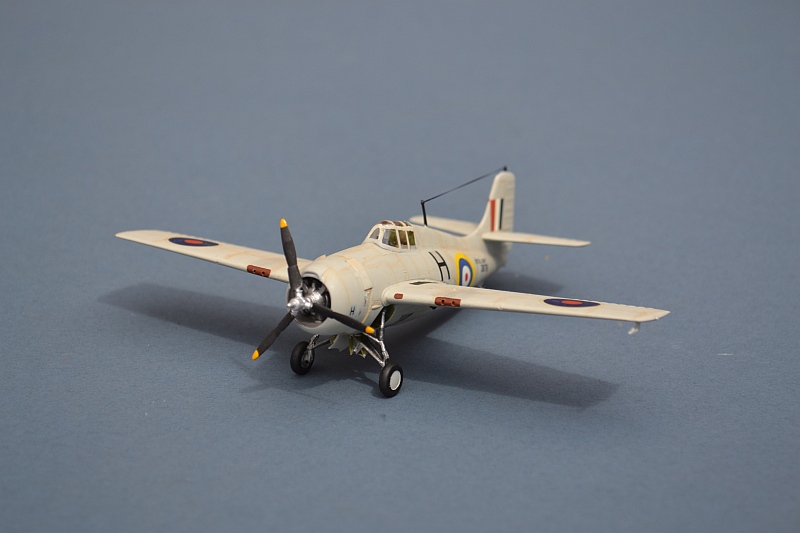
This is yet another HobbyBoss Wildcat kit, using some of the spare decals from a Hasegawa Martlet built a few years back. Assembling this very simple kit takes about 15 minutes, but a comparison with the acclaimed Hasegawa kit still shows it to be a satisfactory replica.
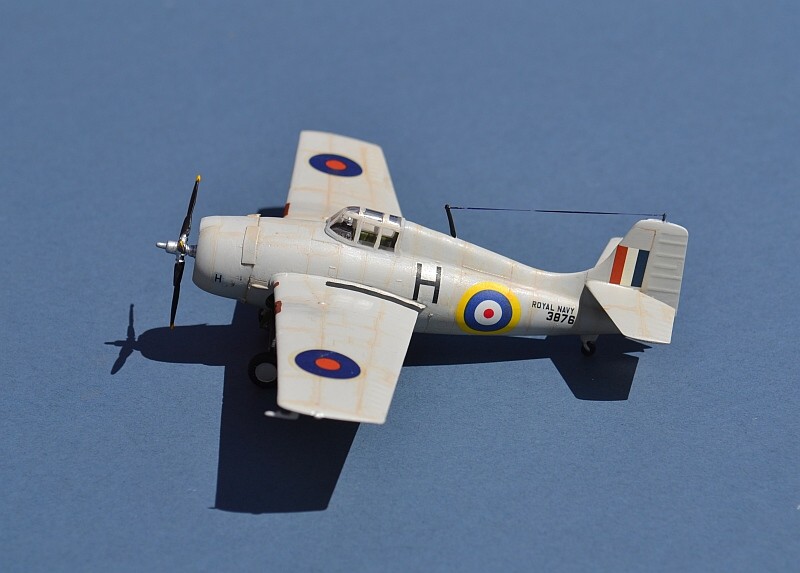
I have made only a few minor changes, adding large single cooling flaps to each side of the engine cowling to replace the nicely moulded small ones, filling the superfluous outer wing guns and the wing fold panel lines.
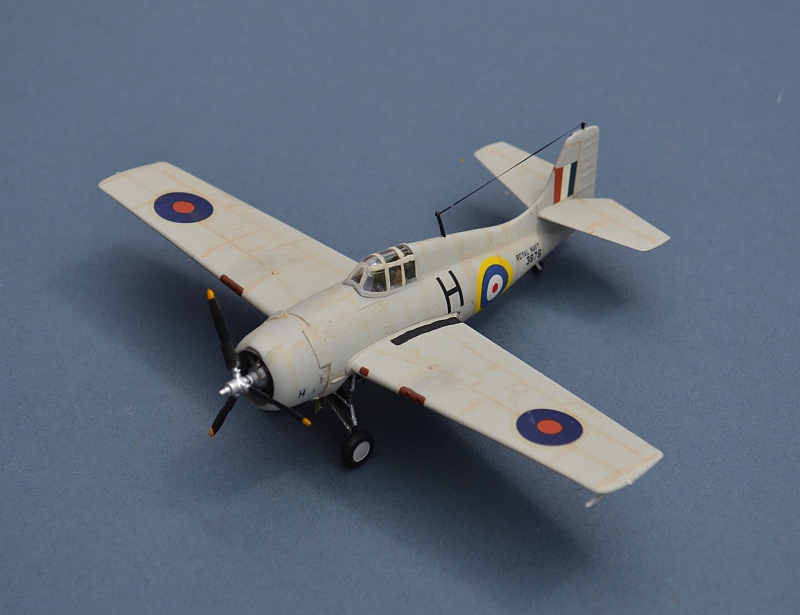
I do like these inexpensive HobbyBoss Wildcats and already have another FM2/Wildcat VI ready to build and add to the pack!
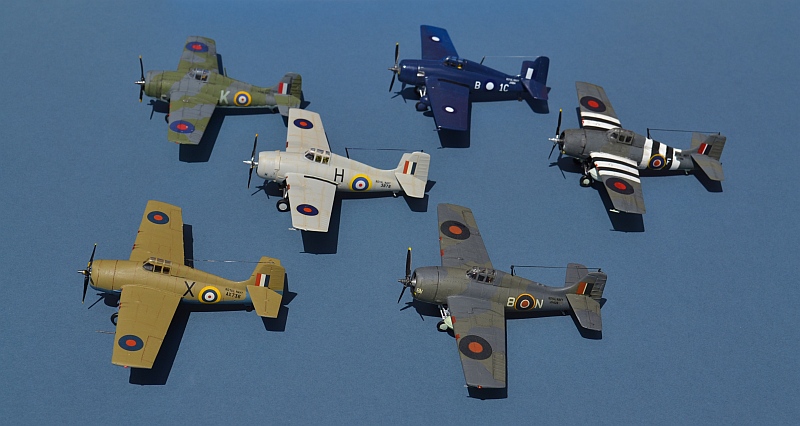
More Martlets and other WW2 RN Aircraft on my RN Props page
805 Squadron / VF-805, Royal Australian Navy, HMAS MELBOURNE, Spithead, June 1977
Hasegawa, 1/72 with ModelDecal transfers.
After re-forming with Seafires for the Pacific campaign, 805 Sqn finally disbanded in 1948, but was immediately resurrected as a Royal Australian Navy Squadron. Initially equipped with Sea Furies and embarked in the RAN's first aircraft carrier, HMAS SYDNEY, the squadron saw active service in Korea, before transitioning to the Sea Venom in 1958, embarked this time in HMAS MELBOURNE.
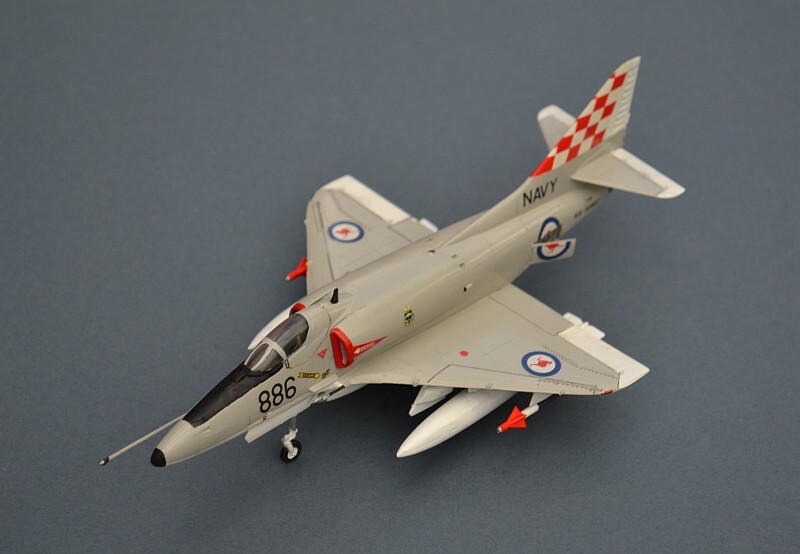
In 1968, 805 Sqn received its first A-4G Skyhawks, an aircraft it would retain until the end of RAN fixed-wing flying in 1982. Small enough to operate from the RAN's limited carrier deck space and offering increased operational compatibility with the USN, the A-4 packed a powerful punch for its size, costing less than half the price of an F-4, but capable of carrying a greater weapons load.
In 1977, HMAS MELBOURNE brought her A-4Gs to the Solent to participate in the HM The Queen's Spithead Silver Jubilee Fleet review.
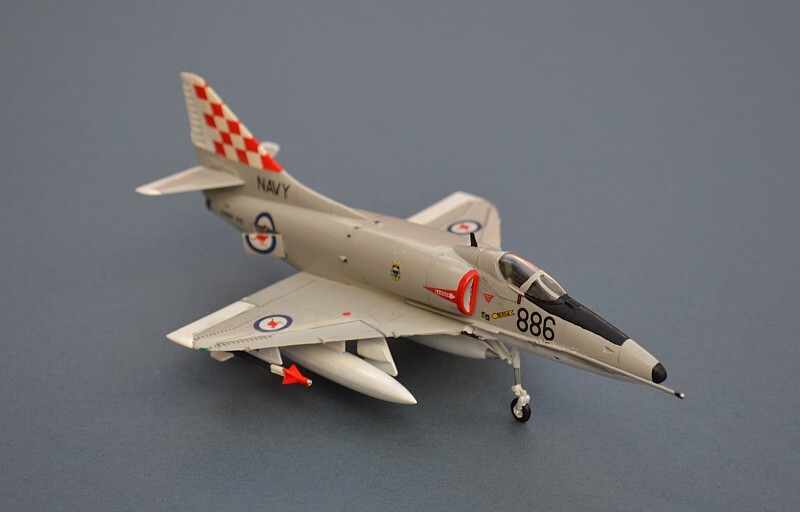
After struggling with the very crude old-mould Airfix Skyhawk in May, this Hasegawa/Frog one has been much, much better. In fact I originally planned to use this kit as a Falklands example, but hadn't realised just how different the various marks of Skyhawk were. Instead, I have used some Modeldecal transfers to turn this one into an Australian aircraft from the RAN's deployment of HMAS MELBOURNE and her air group to European waters for the Spithead review, part of the 1977 Queen's Silver Jubilee celebrations, exactly 35 years ago. Interesting to think how things have changed since then!

The kit has effectively been built "out the box", apart from removing the USN under-nose ESM antenna that wasn't fitted to RAN aircraft. Typical of 1970s Hasegawa, it fits together perfectly and has fine raised panel lines although it appears to be slightly over-scale. The RAN's aircraft were used in the air defence role as well as strike/attack, so I have added an early model Sidewinder to each of the outer pylons
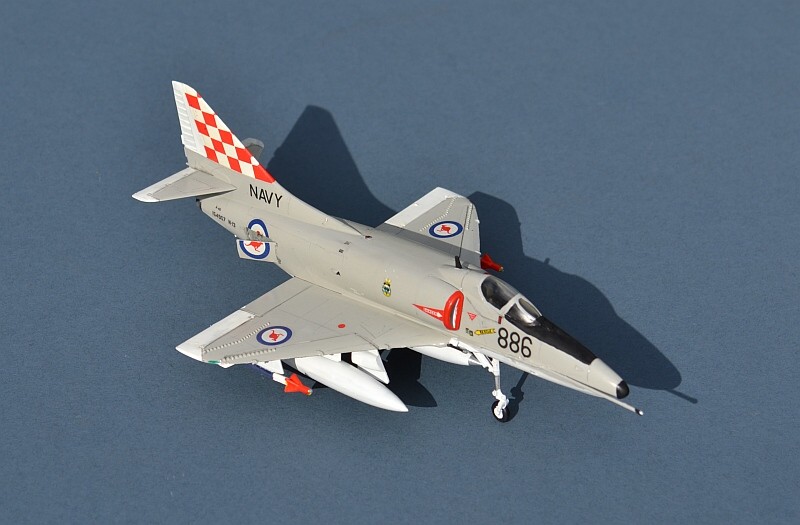
I have another one of these very nice little kits in the stash (a Frog issue) which I hope to do very soon as a kiwi A-4K.
Have a look at my Friend & Allies Pages
REME, British Army Of The Rhine, 1977
B.W. Models, 1/76.
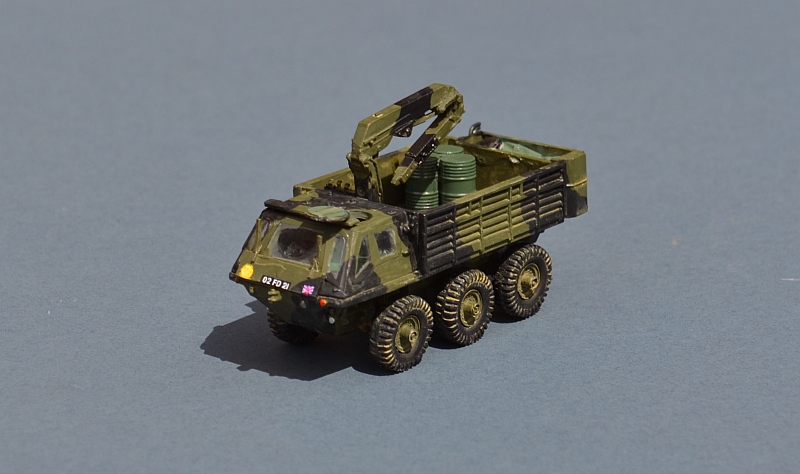
Entering service in the mid 1960s, the Stalwart, or "Stolly" was another manifestation of Alvis' successful FV600 series. Using much the same running gear as the Saracen, Salamander and Saladin vehicles, the Rolls Royce engine was moved to a low central position underneath the load carrying deck and connected to a pair of steerable Dowty waterjets, making the Stolly fully amphibious. As well as a 5 ton carrying capacity and creditable performance in the water, the Stalwart had a remarkable off-road ability, although its rather crude transmission was prone to excessive wear and breakdown when it was used on-road.
The Royal Electrical and Mechanical Engineers (REME) were formed 70 years ago in October 1942, from elements of the Royal Army Ordnance Corps (RAOC), Royal Engineers (RE) and Royal Army Service Corps (RASC).
REME units used the Stolly as a mobile workshop, developing a successful "tag-team" approach that combined tracked and armoured FV430 series repair vehicles at the front-line and the faster, lighter and more agile wheeled Stalwarts supporting them behind the lines.
Stalwarts gave excellent service, but were finally withdrawn from service in the very early 1980s, not least because of their thirsty petrol fueled engines.
I am a great fan of B.W.'s white metal kits, which include an unrivalled range of nicely detailed post-war British military vehicles, including some very useful accessories such as vehicle loads and transfers. They are not particularly cheap though and do require some care and skill to assemble.
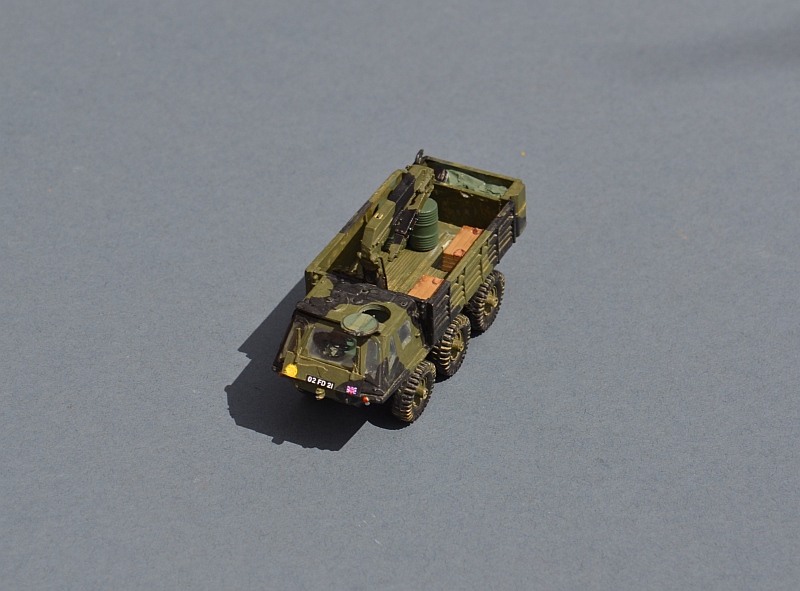
White metal is definitely not my favourite modelling medium though! Having had some difficulty getting a sufficiently strong attachment of the wheels on my Ferret Armoured Car, I attempted to solder these - all I can say is "don't, it doesn't work" and I eventually returned to the superglue. Glazing this vehicle was also quite difficult; I managed the front windows reasonably well, but the side ones defeated me. I ended up with a reasonable stab, but I'm not happy with them and I may eventually try to re-do them.
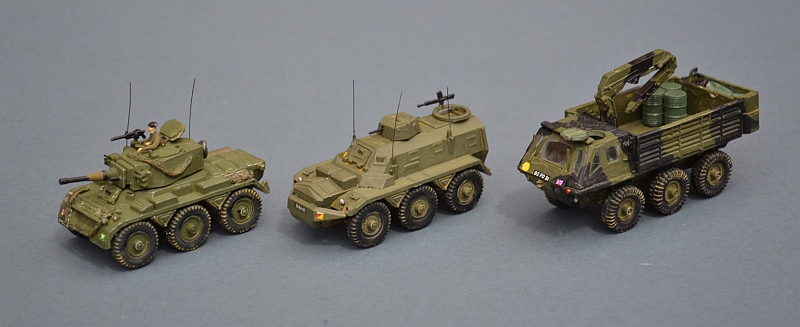
Three
of my models of FV600 Series vehicles together;
Saladin,
Saracen (both Airfix/JB Models) and Stalwart (B.W. Models)
The cab comes with a reasonable interior of seats, instrument panel, steering wheel, gear sticks (3 of them) and a handbrake. This is the Mk2 version with the REME crane - B.W. also make a Mk 1 (different shaped cabin windows) and a fully loaded version used as an amphibious crash vehicle at RAF GAN.
Many more AFVs and tanks on my Dark Side pages
Link
to previous month Link
to Next Month
Background
Picture - Commonwealth Troops advance at El Alamein, July 1942
©Crown
Copyright IWM (E 18474)
www.gengriz.co.uk